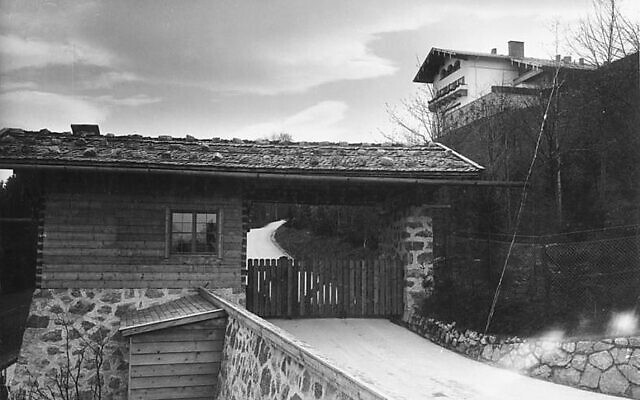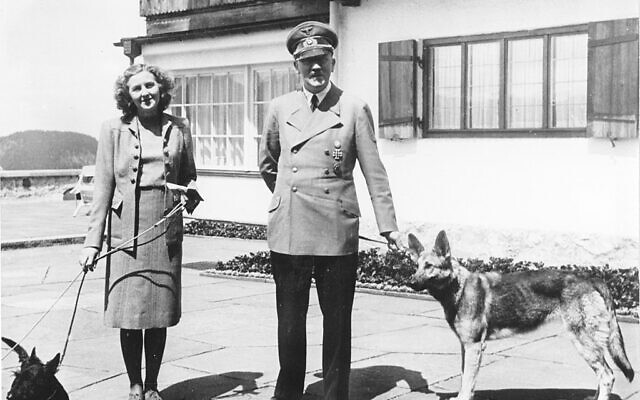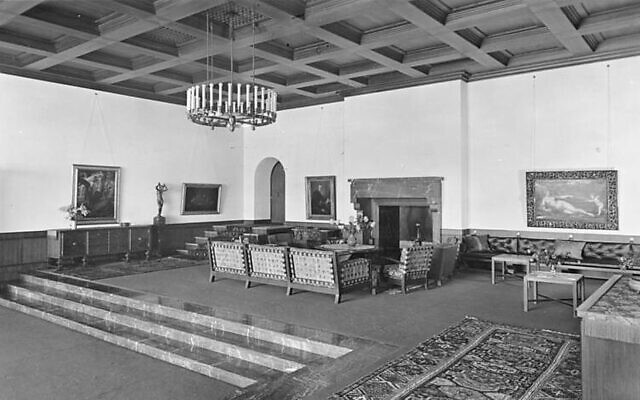LONDON — The plan was simple in conception but fiendishly difficult in execution. A lone sniper would hide in the woods around the Berghof, waiting for Adolf Hitler to pass on his daily 20-minute stroll in the Bavarian Alps. With his SS bodyguards ordered to keep their distance, the Nazi tyrant would be effectively alone and exposed.
Although it never got off the drawing board, Operation Foxley — the UK intelligence service’s secret plan to assassinate Hitler — shines a fascinating light on British thinking about how to kill the head of the Third Reich — and what the consequences might be.
It also reveals the depths of British knowledge about Hitler’s daily routine and security, as well as some startling omissions and misconceptions.
The subject of a recently published book by author Eric Lee titled, straightforwardly enough, “Britain’s Plot to Kill Hitler,” Operation Foxley was the cover for a series of options dreamed up by Britain’s spooks to assassinate Hitler and bring the war to a swift close. They ranged from the plausible to the seemingly bizarre, including a “Manchurian Candidate”-style fantasy to hypnotize Rudolf Hess and send him back to Germany to kill top Nazis.
Although Britain had begun toying with how it might kill Hitler in 1938, it was not until three years later that an initial operation to do so was actually approved. Little is known about that effort. However, in late June 1944, the Special Operations Executive (SOE) — a secret espionage and sabotage organization established by Winston Churchill soon after he became prime minister in 1940 — decided to once again begin drawing up plans.
Get The Times of Israel's Daily Edition by email and never miss our top stories
Lee believes the decision to launch Operation Foxley so late in the war is not as strange as it may at first seem. While some on the Allied side believed that, in the wake of D-Day, British and American troops might soon storm their way to Berlin, others were much more cautious, believing the war might still have years to run.

Eric Lee, author of ‘Britain’s Plot to Kill Hitler.’ (Courtesy)
“They really didn’t know the full strength of the Germans and how they’d fight and a lot was dependent on how the Soviets were doing,” Lee tells The Times of Israel. “If they could have killed Hitler in June or July 1944, that would have shortened the war by a lot.”
With the prime minister’s permission to kill Hitler seemingly having been granted in 1941, no new approval was required or sought. Records reviewed by Lee also show that there were no internal discussions about either the morality or legality of assassinating the leader of Britain’s wartime enemy. Indeed, Britain had already shown it was willing to participate in efforts to kill senior Nazis, having trained and equipped Reinhard Heydrich’s Czech assassins in 1942.
“It never came up in their conversations,” says Lee. “It was a complete non-issue for them.”
The lone gunman
As the Operation Foxley dossier released by the British government (and reproduced in an appendix to Lee’s book) shows, while many proposals were considered, the most likely was the infiltration of a sniper into the woods around Hitler’s Alpine retreat close to Berchtesgaden in Germany’s far southeast.
The dossier contains a welter of photographs, drawings and intelligence about Hitler’s routine when he was staying at his Berghof vacation home, security precautions and staffing, as well as the topography of the local area and layout of buildings at the Obersalzburg mountain complex. It also contained a section euphemistically titled “possibilities of action in the Berchtesgaden area.”
The plan bore a remarkable similarity to the popular 1939 British novel ‘Rogue Male’
The plan itself — a lone sniper in the woods staking out the Berghof and waiting for Hitler to begin his daily walk — bore a remarkable similarity to the popular 1939 British novel “Rogue Male,” which itself received the Hollywood treatment two years later in the film “Man Hunt.” However, while the author of the book Geoffrey Household worked for SOE, Lee found no evidence that he worked on, or was aware of, the assassination planning. Nonetheless, he writes, those working on Operation Foxley were “surely aware” of the book and the film.
While fictional novels may have provided some inspiration, it was the interrogation of German prisoners by the British authorities which gave SOE the key tidbit of information from which the plot itself flowed.

Entrance to the Berghof. (Bundesarchiv Bild/ CC-BY-SA 3.0)
Under questioning, soldiers who had served as part of Hitler’s security detail revealed that, since mid-March 1944, the Führer had almost always taken a daily 20-minute walk from the Berghof to the nearby Teehaus where he took breakfast.
Throughout the walk, which commenced between 10 and 11, Hitler had no security close at hand. “Hitler cannot bear to feel himself watched,” noted the dossier, so his guards were told to keep the Führer in view, while remaining unobserved themselves. The orders meant that, at times, Hitler’s bodyguards were around 500 meters away.
By contrast, maps contained in the dossier indicated that the sniper, who would be dressed in the German army mountain troops’ uniform, should be able to get within 100-200 meters (up to 660 feet) of the path Hitler would walk along. To complete the agent’s cover, he would use a German standard issue Mauser Karabiner 98 kurz sniper rifle and carry a pistol, fitted with a silencer, and hand grenades.
If the assassination attempt failed, the SOE worked out a backup plan. It would require two agents to be placed near the Teehaus with a bazooka, which would be fired at Hitler’s car as it left for the return journey to the Berghof (the Führer never walked back, the dossier indicated, but was always driven home). The beauty of the backup plan, the SOE believed, was that “the guards would hardly expect a second attack to be made.”
Who did the SOE have in mind to fire the fatal shot which, it was hoped, might bring down the Third Reich and end the war? Attention appeared to be focused on the unlikely figure of Captain Edmund Bennett, who, at the time inquiries began to be made about him in early 1945, had been posted to work on the staff of the British defense attaché in Washington, DC.

Hitler, Hermann Göring and Nazi politician Baldur von Schirach at the Teehaus at Hitler’s vacation home in the Bavarian Alps, in this undated photo taken prior to July 1944. (Bundesarchiv bild/ CC-BY-SA 3.0)
Bennett, however, wasn’t an SOE agent or a native German speaker, and also suffered from an astigmatism that caused blurry vision. The references to Bennett, says Lee, are “extremely odd.” The SOE had a German section with plenty of native German speakers, as well as “crack snipers” at its disposal who had “dozens of kills on record.” Lee believes that, because the documentary record is not complete, there must have been other candidates. The only other explanation, he adds, is “incredible ineptitude on the part of SOE.”
Hitler truly did believe that he was under some kind of divine protection
Hitler’s daily, unguarded walk flew in the face of comments he had previously made about stopping an assassin piercing his normally multi-layered rings of security. “The only preventive measure one can take is to live irregularly — to walk, drive and to travel at irregular times and unexpectedly,” he had told colleagues. As Lee notes, Hitler’s abandonment of that caution at Berchtesgaden — where he sometimes spent weeks — perhaps indicated that, after surviving countless assassination attempts, “he truly did believe that he was under some kind of divine protection.”

‘Britain’s Plot to Kill Hitler,’ by Eric Lee. (Courtesy)
The importance of routine was highlighted by the British themselves, who also considered the option of attempting to kill Hitler at the nearby Klessheim castle, where his Führersonderzug special train was often kept in the sidings while he was staying in Berchtesgaden. An agent, it was suggested, might be employed to approach the train and throw a suitcase of explosives under it. But while the dossier contained details of the route Hitler’s motorcade took to Klessheim and how heavily it was guarded, it conceded that the timing of an attack was difficult to assess. It was “considerably more difficult” to predict than his walk to the Teehaus and would require the car park at the Berghof to be kept under “constant observation.”
Who by poison?
The Führersonderzug was nonetheless to be the setting for another potential plan floated by Operation Foxley planners. This envisaged an attempt to poison Hitler with thallium. Its “chief advantage,” the dossier noted, was the substance produced no initial symptoms, was tasteless and odorless, and thus potentially ensured that Hitler would take a sufficiently lethal quantity before suspicions were aroused.
Despite extensive sketches of the Führersonderzug — and details of how it was guarded and serviced — the SOE planning became distinctly hazy when it came to the question of how precisely the poison would be introduced into the train’s drinking water. The dossier suggested that it could be poured into a water tank in the kitchen of the dining car and noted that the train’s French female cleaning staff were “apparently approachable” and “an attempt to suborn one of them might be worthwhile.”
As Lee suggests, while the sniper plot was “plausible” — a trained, properly equipped assassin should have been able to kill a target at such a distance — it still contained major holes. Crucially, unlike in occupied Europe, where it worked closely with the resistance, the SOE had no operation inside Germany; consequently, the planners had no developed proposals to smuggle its sniper into — and, if he survived, out of — the country. The SOE’s weakness in Germany was evident again in the Führersonderzug plot where there were no contacts with either the French cleaners or local operatives who might have been able to help poison the train’s water supply.
I think this was purely theoretical. They didn’t have anyone on the ground
“I think this was purely theoretical,” Lee says. “It was speculation. They didn’t have anyone on the ground.”
Both plots had been greatly assisted by the information given up under questioning by German POWs who had worked in close proximity to Hitler. While this huge security lapse was corrected towards the end of the war, it was, Lee says, “remarkably stupid and part of the German arrogance; the belief that Germans wouldn’t surrender and fall into Allied hands and, if they did, they would certainly never talk.”

Hitler came close to death shortly after Operation Foxley was approved when a bomb went off in his Wolf’s Lair on July 20, 1944. (Bundesarchiv Bild/ CC-BY-SA 3.0)
In reality, the dossier reveals that German captives provided a wealth of information to the Allies. Beyond the details about Hitler’s daily walk to the Teehaus and how he traveled to Klessheim, the SOE learned how its agents could ascertain if the Führer was at the Berghof.
German captives provided a wealth of information to the Allies
The clues included the appearance of a large swastika flag outside, as well as the presence of off-duty members of his bodyguard unit drinking at named local taverns and cafes. Information about air raid precautions and the location, size and layout of Hitler’s own shelter; local bus services; and approaches to, and viewpoints of, the Berghof were all detailed in the dossier. So, too, was trivia about what Hitler ate for lunch (“vegetables only”) and the mineral water and non-alcoholic beer he liked to drink.
But, perhaps reflecting their low-level rank, some of the other information provided by the German POWs, and reported in the dossier, proved “wildly inaccurate,” says Lee. Eva Braun, his girlfriend and short-lived future wife, for instance, was described as “Hitler’s secretary,” while Josef Goebbels’s marriage was said to have broken down with his wife and children fleeing to Switzerland.

Adolf Hitler and Eva Braun with their dogs at the Berghof vacation house.
(Bundesarchiv Bild/ CC-BY-SA)
Although collected through May 1944, the intelligence also proved fatally dated. The captured Germans may have known about Hitler’s daily routine when he was at Berchtesgaden, but they had no idea about his movements beyond his Alpine home. Unbeknown to the British, Hitler had left the Berghof on July 14, 1944 — two weeks after the decision to launch preparations on Operation Foxley — and he would never return.
As historian Ian Kershaw, who wrote a foreword to Lee’s book, notes: “The timing and character of the feasibility studies of Foxley meant that the plan… never had a chance of being put into operation.” He continues: “All the designs for an assassination attempt were predicated on the attack taking place either at Hitler’s residence at the Berghof… or on his special train, while it was stationed in that area or traveling from that region.”
Hess the hypnotized?
The SOE nonetheless continued to look around for ideas to kill leading Nazis. Perhaps the most bizarre was the suggestion — labeled Foxley II — that it might be possible to hypnotize Rudolf Hess, who was in British hands after making an unexplained, solo flight to the UK in 1941, to carry out the killing.
The notion was originally floated in July 1944 by a senior SOE agent, Major Leopold Herbert Manderstam. He imagined that Hess might be induced to assassinate SS chief Heinrich Himmler, having been led to believe that he was the obstacle to a peace deal between Britain and Germany. Later, senior SOE leaders began examining whether Hess might be hypnotized to kill other top Nazis, including Hitler.
Although there were huge obstacles to such a plan — Hess, for instance, was, by this point, viewed as a traitor or insane by Hitler and his leadership and was thus unlikely to have been allowed access to them — it is not as wacky as it first seems, believes Lee.

The Berghof’s Great Hall. (Bundesarchiv, Bild / CC-BY-SA 3.0)
Indeed, there was a body of academic research into the potential and limitations of hypnosis available at the time which, at the least, made the idea worthy of consideration. Hess, furthermore, was potentially open to hypnosis, being obsessed with the notion, which he described to British doctors in early 1945, that the Jews were using it against Germany.
What seems crazy to historians today was actually in the context of the 1940s based on existing scientific knowledge
“What seems crazy to historians today was actually in the context of the 1940s based on existing scientific knowledge,” Lee says. “Look at how susceptible Hess personally was to hypnotism, he was about as susceptible as you get.”
But would the assassination of Hitler at this relatively late stage in the war have made any difference?
The various potential outcomes of the Führer’s death were much-debated by the SOE. From the Allies’ vantage point, the optimal impact was that his assassination would bring about the kind of rapid implosion of the Third Reich that in fact occurred after Hitler’s suicide in late April 1945.
But might the Führer’s assassination have resulted in a more competent leader taking the helm and potentially prolonging the war or attempting to cut a deal with the western Allies?
In reality, believes Lee, it was too late for either of these scenarios to have played out. Committed to Germany’s unconditional surrender and seeing the end was in sight, Britain and America had no incentive — even if they had been so inclined — to negotiate a separate peace. At the same time, his likely successors, such as Himmler or Hermann Goring, were scarcely more militarily competent than Hitler and would not, argues Lee, have been able to revive Germany’s fortunes.
Kershaw believes that some within the SOE’s senior ranks were more concerned about the postwar period. They feared that the notion of a “martyred” Führer might have further radicalized the Nazis’ die-hard supporters.
However, even by early 1945, it was not too late for Hitler’s assassination to have mattered enormously to a continent on which he had already wrought untold suffering and death. A successful attempt in the summer of 1944 would have cut a whole year off the war.
As Lee argues, the massive German counteroffensives of late 1944, the rising toll in the death camps, and the fact that the conflict’s final weeks were among its bloodiest indicate that, at any point before May 1945, Hitler’s death could have saved a great number of lives.


